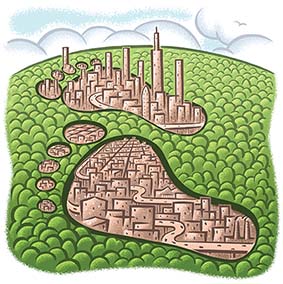 |
 |
| current issue |  | past issues |  | send a letter/news |  | address update |  | advertise |  | about us |  | alumni home |
|
Inquiring Minds By Hillary Rosner Illustrations by Timothy Grajek |
Easy to print version |
In this issue:
Ocean InterloperBad Blood
Beyond the Footprint
Ocean Interloper
Monitoring a new species of seaweed.
Lindsay Green '14G wasn't expecting to find anything unusual on the sea floor that day. It was a routine diving expedition for her and her colleague Hannah Traggis '95, '14G. A doctoral candidate in plant biology, Green studies seaweed aquaculture—specifically, cultivation of local varieties of nori, which is used to wrap sushi. In the summer, she collects blades of wild seaweed to get spores for her project.

|
But on a July day in 2011, Green saw something interesting in the water off the coast of Kittery, Maine. It was a seaweed resembling a big brown beach ball. "I collected it because I thought it was really cool," she recalls. "I pressed it out on a specimen sheet, filed it away, and didn't think anything of it." When she reviewed her specimens later with her adviser, plant biologist Christopher Neefus '82G, he recognized the seaweed as a type of sea potato—a species he knew wasn't normally found in Maine. "We set out on a quest to identify it," Green says.
The team developed genetic markers to identify the mystery seaweed, and they found an exact match with samples of Colpomenia peregrina, a Pacific Ocean species found in Nova Scotia since the 1960s. Although Green's discovery, which she and her colleagues reported in the journal Botanica Marina, was the first documented occurrence of the seaweed in the Gulf of Maine, the brown sea potato has since spread rapidly, at least as far south as Cape Cod. Green recommends that beachgoers who spot the seaweed report it to their local department of marine resources, although she cautions that it's easy to confuse it with a native seaweed known as sea cauliflower (Leathesia marina).
The sea potato is an epiphyte, which means it grows on top of other seaweeds. That could give it a competitive advantage, helping it push aside the native species. And its tendency to attach to oyster shells and float off with them has earned it another nickname: the oyster thief.
But it's too soon to know why the sea potato is here and whether it will turn out to be an invasive species. So sightings of brown, puffy seaweed on the beach are no cause for alarm. The sea potato—for the moment at least—is simply a curiosity.
—H.R.
Bad Blood
Not all bullies are on the playground.
Bullying—on playgrounds, in locker rooms, online—has garnered national attention in recent years, and numerous books, movies, and programs have been developed to address this pervasive childhood affliction. But the focus has been almost exclusively on bullying by peers. Now UNH researchers are training a lens on a different type of bully: one who shares the dinner table, and even DNA, with the victim.

|
In a recent study published in the journal Pediatrics, Corinna Jenkins Tucker, associate professor of family studies, and three collaborators from the UNH Crimes Against Children Research Center found that sibling aggression was associated with the same detrimental effects—anxiety, depression, anger—as other types of bullying. The researchers looked at children and adolescents as well as at a variety of types of aggression, including physical assault (with or without an object or injury), property aggression (such as breaking or forcibly taking something), and psychological aggression (mainly verbal abuse). Across all these categories, the researchers found that even a single instance of bullying was linked to mental distress. The problem also appears to be fairly widespread: In the study, more than 30 percent of children and adolescents reported experiencing sibling aggression at least once in the previous year.
"Typically, aggression that happens between siblings is seen as just rivalry, normal behavior," Tucker says. "We have different norms when it comes to aggression in the sibling relationship." Some parents tolerate sibling aggression, she says, because they believe "it's good training for conflict resolution in other relationships."
Tucker and her collaborators—sociologists David Finkelhor '78G, Heather Turner, and Anne Shattuck '07G, '15G—suggest that anti-bullying programs should be expanded to include sibling aggression. "We will continue to look at this," says Tucker. One crucial question on her research agenda: What preventive action can parents take?
—H.R.
Beyond the Footprint
Cities are spreading out—and up.
A cross the planet, urban areas have ballooned during the last couple of decades. Today, up to 80 percent of global energy consumption occurs in cities, which now house the bulk of the world's growing population. Steve Frolking '80, '83G, '93G, a research professor of biogeochemical modeling, has developed a new way to monitor the growth of "megacities" around the world—and discovered some surprising differences in the form that growth is taking in different countries.
In India, Frolking found, cities have sprawled outward over the past decade, stretching and spreading as they take up more land. In global capitals like London and Tokyo, meanwhile, growth has taken a vertical path, with high-rise buildings creeping toward the sky. And in China, massive urban expansion is moving both upward and outward. "There was a profound difference between the trends of cities in China and India," says Frolking.

|
The project—the first to monitor upward as well as outward growth of cities—relied on global satellite data from a tool called a "scatterometer," which bounces microwaves off objects on the ground. Although the instrument was designed to measure wind speed over the ocean, Frolking had been using it to study changes in the tropical forest canopy in heavily deforested areas like Brazil and Indonesia. "You can think of it as a satellite flying around with a radar gun," he says. "So as a landscape goes from bare ground to trees, more of the waves bounce back." Puzzled by data that seemed to indicate that areas in China were being reforested, he shared his results at a meeting in Indonesia. Frolking and a colleague soon realized those "forests" were actually cities—microwaves bouncing off not rainforest trees but buildings and sidewalks. Suddenly, a whole new application for the radar data had emerged.
Frolking spent a year and a half analyzing the urban signals documented from 1999 to 2009, enlisting help from Tom Milliman '87G, a UNH physicist, as well as researchers from Yale and Boston University. The results reveal "previously undocumented recent and rapid changes in urban areas worldwide that reflect pronounced shifts in the form and structure of cities," they wrote in a paper published last spring.
Although he generally studies natural phenomena, Frolking says the urban project has made him notice things he wouldn't have noticed before. For instance, while reading a magazine recently, he was struck by the similarity between a map of Walmart construction in China and a map of "backscatter"—the bounced-back microwaves the UNH researchers have seen as indicating urban structures—that Milliman had made. "It makes sense, because the big signal in China is from residential buildings," Frolking says. "And if you have residential buildings, you need to furnish them with stuff. And Walmart has stuff."
Although the satellite that collected the radar information is no longer working, Frolking hopes to continue the research with new data from an Indian satellite. Looking ahead, he thinks his findings can ultimately feed into climate models, enabling scientists to more accurately predict how cities will affect and be affected by global warming.
—H.R.
blog comments powered by Disqus

